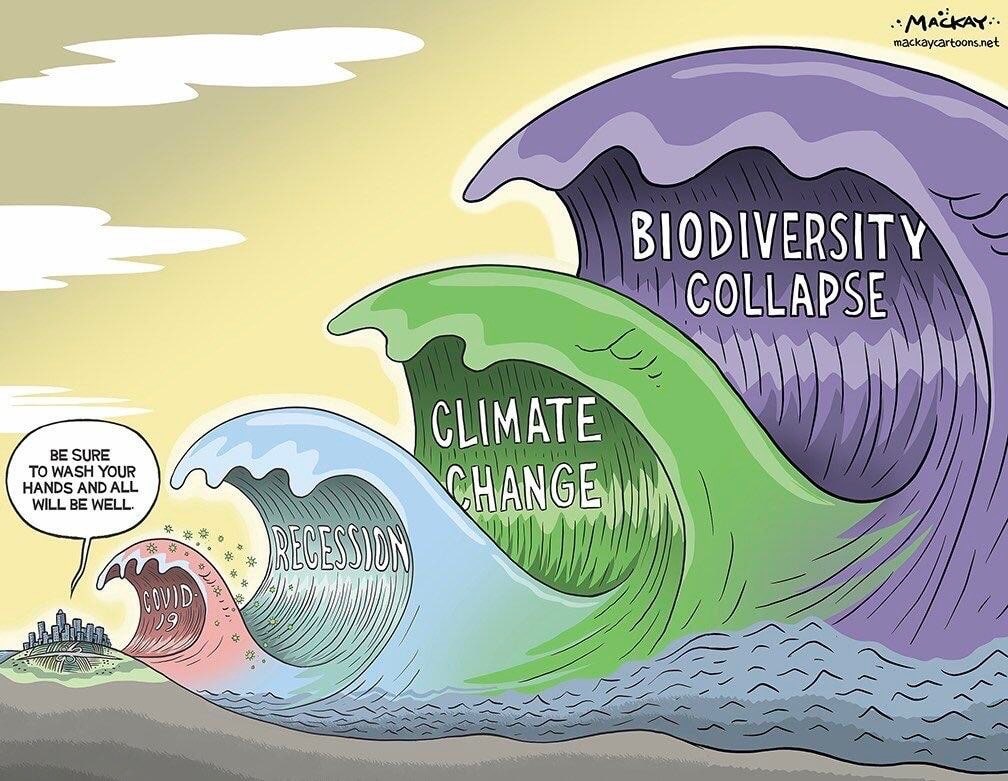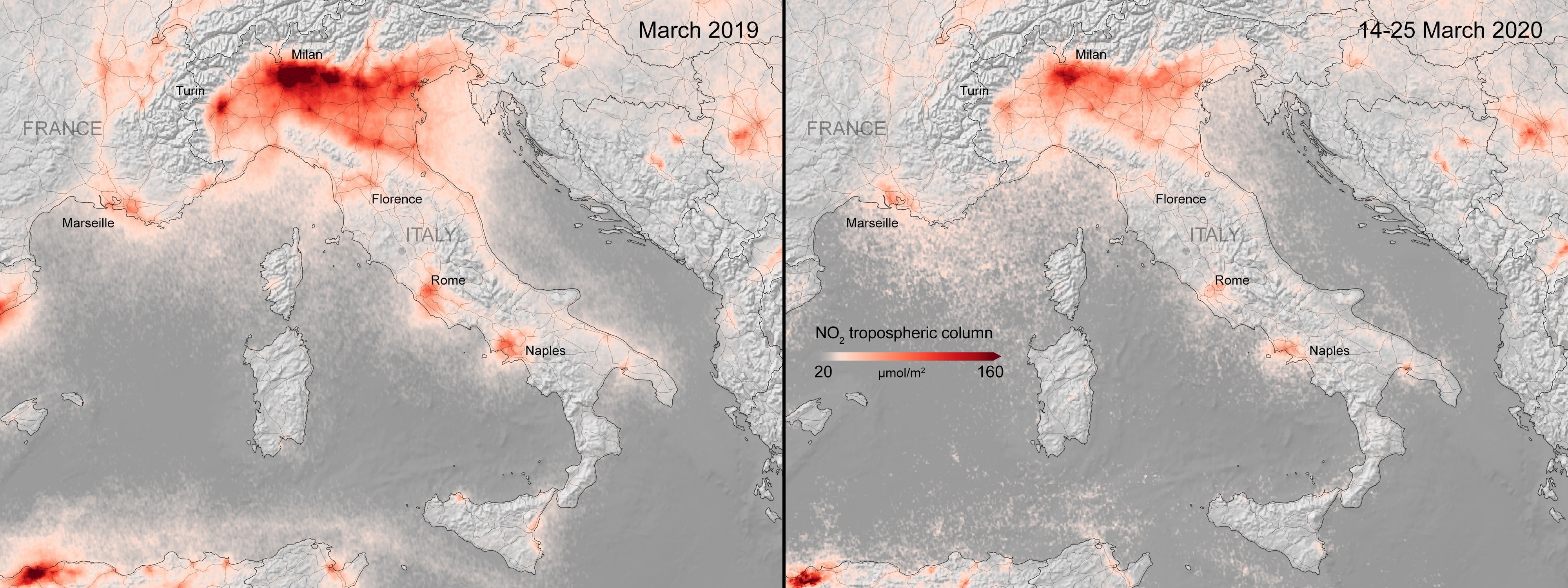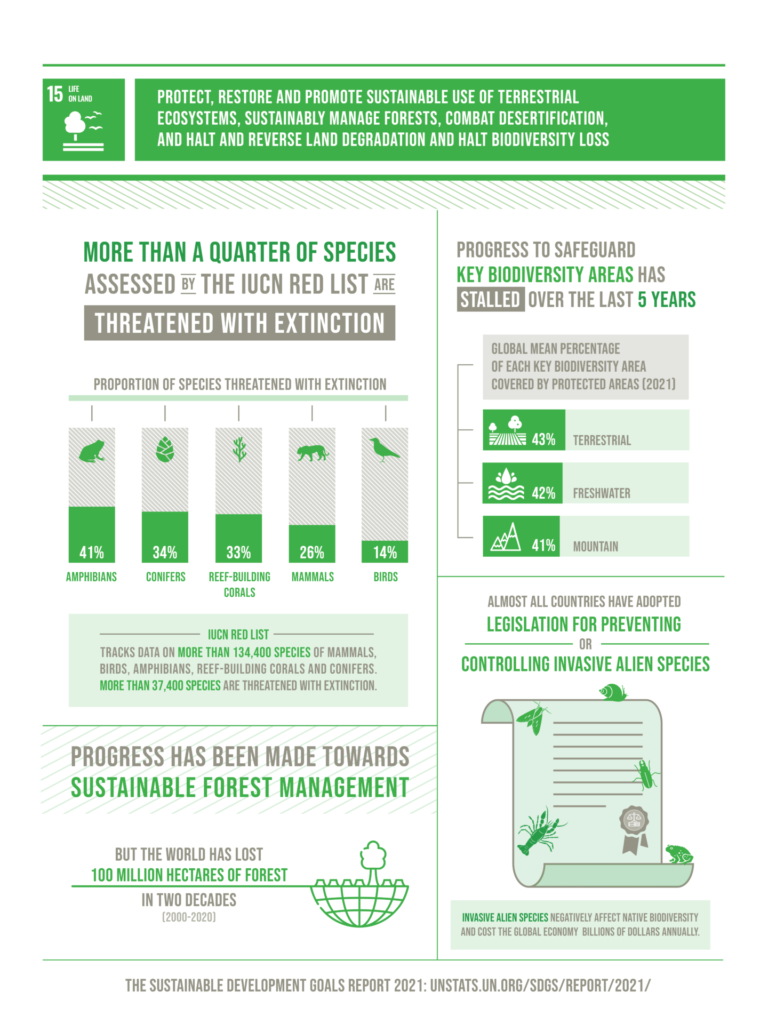
While Humanity struggles to agree on whether, hand hygiene, social distancing, masks, and quarantines help to flatten the curve of COVID-19, the challenges ahead are of a whole different magnitude.
In fact, the temporary setback in economic activity caused by COVID-19 induced lockdowns caused “a three-week relief” in the global Ecological Footprint or 10% compared to last year setting the Earth Overshoot Day 2020 at August 22.
Earth Overshoot Day marks the date when humanity’s demand for ecological resources and services in a given year exceeds what Earth can regenerate in that year.
The main drivers were the carbon Footprint (reduced 14.5% from 2019) and the forest product Footprint (reduced 8.4% from 2019), but we still use as many ecological resources as if we lived on 1.6 Earths.

As public health and economic recovery have emerged as dominant concerns globally, decision-makers are called to act on the unprecedented current disruption to build a future where all thrive within the means of our planet (“one-planet prosperity”). That means to put an end to the endless pursuit of growth even if tech optimists label it “Green Growth”. But honestly, what are the chances we’ll change our behavior in the aftermath of COVID?

Imagine if we could live this way by de-carbonizing industry & transport instead of shutting them down?
Infectious diseases that cause epidemics are often a result of things people do in nature. The disruption of nature causes disease and 60 percent of these infectious diseases are zoonotic; meaning they come from animals first. This includes AIDS, Ebola, swine flu, and mad cow disease
Lama El-Hatow, environmental and social consultant
at the International Finance Corporation (IFC)
The economic downturn caused by COVID-19, according to the World Bank, is predicted to shrink the global economy by 5.2 percent this year—the deepest recession since the Second World War.
The International Energy Agency has forecast the CO2 impact of the crisis, suggesting emissions could fall by 8% this year, some 2,600MtCO2.
For post-COVID-19 recovery, there needs to be social inclusion in terms of health care and education infrastructure, investments in renewable energy, and a move to a more digital economy that includes e-commerce, e-payments, e-learning, and e-governance.
Se dette innlegget på Instagram
The Paris Agreement is five years and Greta and here #FridaysForFuture movement has been urging us to fight the Climate Crisis for more than two years. The US has withdrawn from the Paris Agreement and more or less resigned as the so-called leader of the free world. As a society within common planetary borders we are barely moving, our politicians are ether betraying us, incapable of understanding the urgency, or simply not up to the task of addressing the largest assignment of our time.
And still, tech optimists think we can invent us out of it, they gather around Green Growth, preaching to save the Climate through renewable energy while destroying more and more Nature.
The danger of the “environmental-industrial complex”
Jens Stoltenberg has a sensational chapter – “Biobråk” – in his book Min historie. He refers to President Eisenhower’s farewell speech in 1961, in which the old general warns against the “military-industrial complex” – the political pressure from the common interest between the Armed Forces and the military industry.
Stoltenberg draws a parallel to two important environmental issues from his time as prime minister, where he knew he had the science and the facts on his side, but still lost politically. Politicians were outmaneuvered by an “environmental-industrial complex” of business interests and lobby groups from parts of the environmental movement.
Doubtful effect
The two cases are electricity certificates, misleadingly called “green certificates”, and biofuels. The electricity certificates created a subsidy industry financed by ordinary consumers. They involved the development of otherwise unprofitable wind and hydropower plants, increased exports of surplus power, increased consumption, and lost money for the community. As an environmental measure, it had a dubious effect, but gained traction as a symbolic issue for the “green shift”.
The second case concerned the introduction of a toll on biofuels that the Prime Minister wanted. The environmental-industrial complex had realized that the “green shift” demanded a tax exemption. This case came up again with full force after the Government set an ambitious goal of gradually increasing the involvement of biofuels. Stoltenberg insists that he had a factually well-founded view – biofuels would increase greenhouse gas emissions, displace food production, provide more expensive food, increase profitability for cultivation in felled or burned rainforest, more transportation of raw materials, and more car traffic.
In the questions about electricity certificates and biodiesel, the authorities have made decisions without scientific advice.
Influence from business interests, lobbyists and committed idealists has been crucial, in addition to the game between government, support parties and opposition.
Polluter pays
A key economic point that Stoltenberg emphasizes is that environmental taxes and climate quotas are generally better for the environment than subsidies. This means that polluters pay, while subsidies create state-subsidized special interests. These favored interests then become an increasingly strong pressure group to maintain the subsidy scheme, whether it is beneficial to the environment or not. Central politicians recently sent out a signal that the scheme with Norwegian-Swedish electricity certificates will be extended until 2030.
Political game
The significance of the scientific communities for climate policy is twofold. On the one hand, research-based insight has had great political significance for the diagnosis of the problems. The UN Climate Panel has made a breakthrough. On the other hand, scientifically-based advice is significantly weaker in the choice of instruments. Here, lobbying, economic pressure, political games, and ideological beliefs have a far more central place. Broad scientific advice and professional consultations would make a difference.

The state of the planet is broken
On December 2. at Columbia University, the UN Secretary-General Antonio Guterres delivered a landmark speech on the state of the planet, setting the stage for dramatically scaled-up ambition on climate change over the coming year. Mr. Guterres wants to put tackling climate change at the heart of the UN’s global mission. The objective, said the UN secretary-general, will be to cut global emissions by 45% by 2030 compared with 2010 levels.
The science is clear unless the world cuts fossil fuel production by 6% every year between now and 2030, things will get worse. Much worse.
Climate policies have yet to rise to the challenge, the UN chief said, adding that “without concerted action, we may be headed for a catastrophic three to five-degree temperature rise this century”.
The impact is already being felt around the world.
“Apocalyptic fires and floods, cyclones and hurricanes are the new normal,” he warned.
Biodiversity is collapsing. Deserts are spreading. Oceans are choking with plastic waste.
We must declare a permanent ceasefire and reconcile with nature.
Here’s what Mr Guterres demanded the nations of the world do:
- Put a price on carbon
- Phase-out fossil fuel finance and end fossil fuel subsidies
- Shift the tax burden from income to carbon, and from taxpayers to polluters
- Integrate the goal of carbon neutrality (a similar concept to net-zero) into all economic and fiscal policies and decisions
- Help those around the world who are already facing the dire impacts of climate change
Humanity is waging war on nature.
Nature always strikes back – and it is already doing so with growing force and fury.
The fallout of the assault on our planet is impeding our efforts to eliminate poverty and imperil food security.
And it is making our work for peace even more difficult, as the disruptions drive instability, displacement, and conflict.
Make peace with nature
Nature needs a bailout. In overcoming the pandemic, we can also avert climate cataclysm and restore our planet.
The trillions of dollars needed for COVID recovery is money that we are borrowing from future generations.
We cannot use those resources to lock in policies that burden them with a mountain of debt on a broken planet.
It is time to flick the “green switch”. We have a chance to not simply reset the world economy but to transform it.
Start carbon neutrality, now
By early next year, countries representing more than 65 percent of global carbon dioxide emissions and more than 70 percent of the world economy will have made ambitious commitments to carbon neutrality.
We must turn this momentum into a movement. The central objective of the United Nations for 2021 is to build a truly Global Coalition for Carbon Neutrality.
Every country, city, financial institution, and company should adopt plans for transitioning to net zero emissions by 2050…(and take) decisive action now.
Put global finance to work for climate
The commitments to net-zero emissions are sending a clear signal to investors, markets, and finance ministers. But we need to go further.
It is time to put a price on carbon. To phase out fossil fuel finance and end fossil fuel subsidies. To stop building new coal power plants.
(It is time) to integrate the goal of carbon neutrality into all economic and fiscal policies and decisions. And to make climate-related financial risk disclosures mandatory.
Protect the most vulnerable
We are in a race against time to adapt to a rapidly changing climate.
Adaptation must not be the forgotten component of climate action. We have both a moral imperative and a clear economic case for supporting developing countries to adapt and build resilience to current and future climate impacts.
The race to resilience is as important as the race to net zero.
Act with urgency – and hope
This is a moment of truth for people and planet alike. COVID and climate have brought us to a threshold.
We cannot go back to the old normal of inequality, injustice and heedless dominion over the Earth. Instead we must step towards a safer, more sustainable and equitable path. The door is open; the solutions are there.
Now is the time to transform humankind’s relationship with the natural world – and with each other. And we must do so together.
Solidarity is humanity. Solidarity is survival.

- Warming beyond 1.5°C will substantially increase the risk of global species extinctions.
- The ocean is already warmer, more acidic, and less productive.
- Around 7 million people die every year from exposure to polluted air.
- Nature-based solutions could provide one-third of the net reductions in greenhouse gas emissions required to meet Paris Agreement goals.
- Bold climate action could deliver $26 trillion in economic benefits by 2030.
- Renewable energy is getting cheaper all the time.
- Switching to a clean economy could produce over 65 million new low-carbon jobs.
- An investment of $1.8 trillion from 2020 to 2030 in adaptation could generate $7.1 trillion in total net benefits.

United Nations Global Goals for Sustainable Development
Sustainably manage forests, combat desertification, halt and reverse land degradation, halt biodiversity loss
Nature is critical to our survival: nature provides us with our oxygen, regulates our weather patterns, pollinates our crops, produces our food, feed, and fiber. But it is under increasing stress. Human activity has altered almost 75 percent of the earth’s surface, squeezing wildlife and nature into an ever-smaller corner of the planet.
Around 1 million animal and plant species are threatened with extinction – many within decades – according to the 2019 Global Assessment Report on Biodiversity and Ecosystem Service. The report called for transformative changes to restore and protect nature. It found that the health of ecosystems on which we and all other species depend is deteriorating more rapidly than ever, affecting the very foundations of our economies, livelihoods, food security, health, and quality of life worldwide.
Deforestation and desertification – caused by human activities and climate change – pose major challenges to sustainable development and have affected the lives and livelihoods of millions of people. Forests are vitally important for sustaining life on Earth and play a major role in the fight against climate change. And investing in land restoration is critical for improving livelihoods, reducing vulnerabilities, and reducing risks for the economy.
The health of our planet also plays an important role in the emergence of zoonotic diseases, i.e. diseases that are transmissible between animals and humans. As we continue to encroach on fragile ecosystems, we bring humans into ever-greater contact with wildlife, enabling pathogens in wildlife to spill over to livestock and humans, increasing the risk of disease emergence and amplification.
COVID-19 response
The COVID-19 outbreak highlights the need to address threats to ecosystems and wildlife.
In 2016, the United Nations Environment Programme (UNEP) flagged a worldwide increase in zoonotic epidemics as an issue of concern. Specifically, it pointed out that 75 percent of all emerging infectious diseases in humans are zoonotic and that these zoonotic diseases are closely interlinked with the health of ecosystems.
“In COVID-19, the planet has delivered its strongest warning to date that humanity must change,” said UNEP Executive Director Inger Andersen.
In Working With the Environment to Protect People, UNEP lays out how to “build back better” – through stronger science, policies that back a healthier planet, and more green investments.
UNEP’s response covers four areas:
- Helping nations manage COVID-19 waste,
- Delivering a transformational change for nature and people,
- Working to ensure economic recovery packages create resilience to future crises, and
- Modernizing global environmental governance.
To prevent, halt and reverse the degradation of ecosystems worldwide, the UN has launched a Decade on Ecosystem Restoration (2021-2030). This globally-coordinated response to the loss and degradation of habitats will focus on building political will and capacity to restore humankind’s relationship with nature. It is also a direct response to the call from science, as articulated in the Special Report on Climate Change and Land of the Intergovernmental Panel on Climate Change, and to the decisions taken by all UN Member States in the Rio Conventions on climate change and biodiversity, and the UN Convention to Combat Desertification.
Work on a new and ambitious post-2020 Global Biodiversity Framework is also underway.
As the world responds to and recovers from the current pandemic, it will need a robust plan for protecting nature, so that nature can protect humanity.
Facts and Figures
- Human activity has altered almost 75 per cent of the earth’s surface, squeezing wildlife and nature into an ever-smaller corner of the planet and increasing risks of zoonotic diseases like COVID-19.
Forests
- Around 1.6 billion people depend on forests for their livelihood, including 70 million indigenous people.
- Forests are home to more than 80 per cent of all terrestrial species of animals, plants and insects.
- Between 2010 and 2015, the world lost 3.3 million hectares of forest areas. Poor rural women depend on common pool resources and are especially affected by their depletion.
- Currently, land degradation has reduced productivity in 23 per cent of the global terrestrial area, and between $235 billion and $577 billion in annual global crop output is at risk as a result of pollinator loss.
Desertification
- Arable land loss is estimated at 30 to 35 times the historical rate
- Due to drought and desertification, 12 million hectares are lost each year (23 hectares per minute). Within one year, 20 million tons of grain could have been grown.
- 74 per cent of the poor are directly affected by land degradation globally.
- Habitat loss and deterioration, largely caused by human actions, have reduced global terrestrial habitat integrity by 30 per cent relative to an unimpacted baseline.
Biodiversity
- Illicit poaching and trafficking of wildlife continues to thwart conservation efforts, with nearly 7,000 species of animals and plants reported in illegal trade involving 120 countries.
- Of the 8,300 animal breeds known, 8 percent are extinct and 22 percent are at risk of extinction.
- Of the over 80,000 tree species, less than 1 percent have been studied for potential use.
- Fish provide 20 percent of animal protein to about 3 billion people. Only ten species provide about 30 percent of marine capture fisheries and ten species provide about 50 per cent of aquaculture production.
- Over 80 percent of the human diet is provided by plants. Only three cereal crops – rice, maize and wheat – provide 60 per cent of energy intake.
- As many as 80 percent of people living in rural areas in developing countries rely on traditional plant-‐based medicines for basic healthcare.
- Micro-organisms and invertebrates are key to ecosystem services, but their contributions are still poorly known and rarely acknowledged.
- While protected areas now cover 15 per cent of terrestrial and freshwater environments and 7 per cent of the marine realm, they only partly cover important sites for biodiversity and are not yet fully ecologically representative and effectively or equitably managed.
Goal 15 Targets
15.1 By 2020, ensure the conservation, restoration, and sustainable use of terrestrial and inland freshwater ecosystems and their services, in particular forests, wetlands, mountains, and drylands, in line with obligations under international agreements
15.2 By 2020, promote the implementation of sustainable management of all types of forests, halt deforestation, restore degraded forests and substantially increase afforestation and reforestation globally
15.3 By 2030, combat desertification, restore degraded land and soil, including land affected by desertification, drought, and floods, and strive to achieve a land degradation-neutral world
15.4 By 2030, ensure the conservation of mountain ecosystems, including their biodiversity, in order to enhance their capacity to provide benefits that are essential for sustainable development
15.5 Take urgent and significant action to reduce the degradation of natural habitats, halt the loss of biodiversity and, by 2020, protect and prevent the extinction of threatened species
15.6 Promote fair and equitable sharing of the benefits arising from the utilization of genetic resources and promote appropriate access to such resources, as internationally agreed
15.7 Take urgent action to end poaching and trafficking of protected species of flora and fauna and address both demand and supply of illegal wildlife products
15.8 By 2020, introduce measures to prevent the introduction and significantly reduce the impact of invasive alien species on land and water ecosystems and control or eradicate the priority species
15.9 By 2020, integrate ecosystem and biodiversity values into national and local planning, development processes, poverty reduction strategies, and accounts
15.A Mobilize and significantly increase financial resources from all sources to conserve and sustainably use biodiversity and ecosystems
15.B Mobilize significant resources from all sources and at all levels to finance sustainable forest management and provide adequate incentives to developing countries to advance such management, including for conservation and reforestation
15.C Enhance global support for efforts to combat poaching and trafficking of protected species, including by increasing the capacity of local communities to pursue sustainable livelihood opportunities
Links
Convention on Biological Diversity
The New York Declaration on Forests
United Nations Convention to Combat Desertification
International Maritime Organization
International Union for Conservation of Nature







Comments are closed.